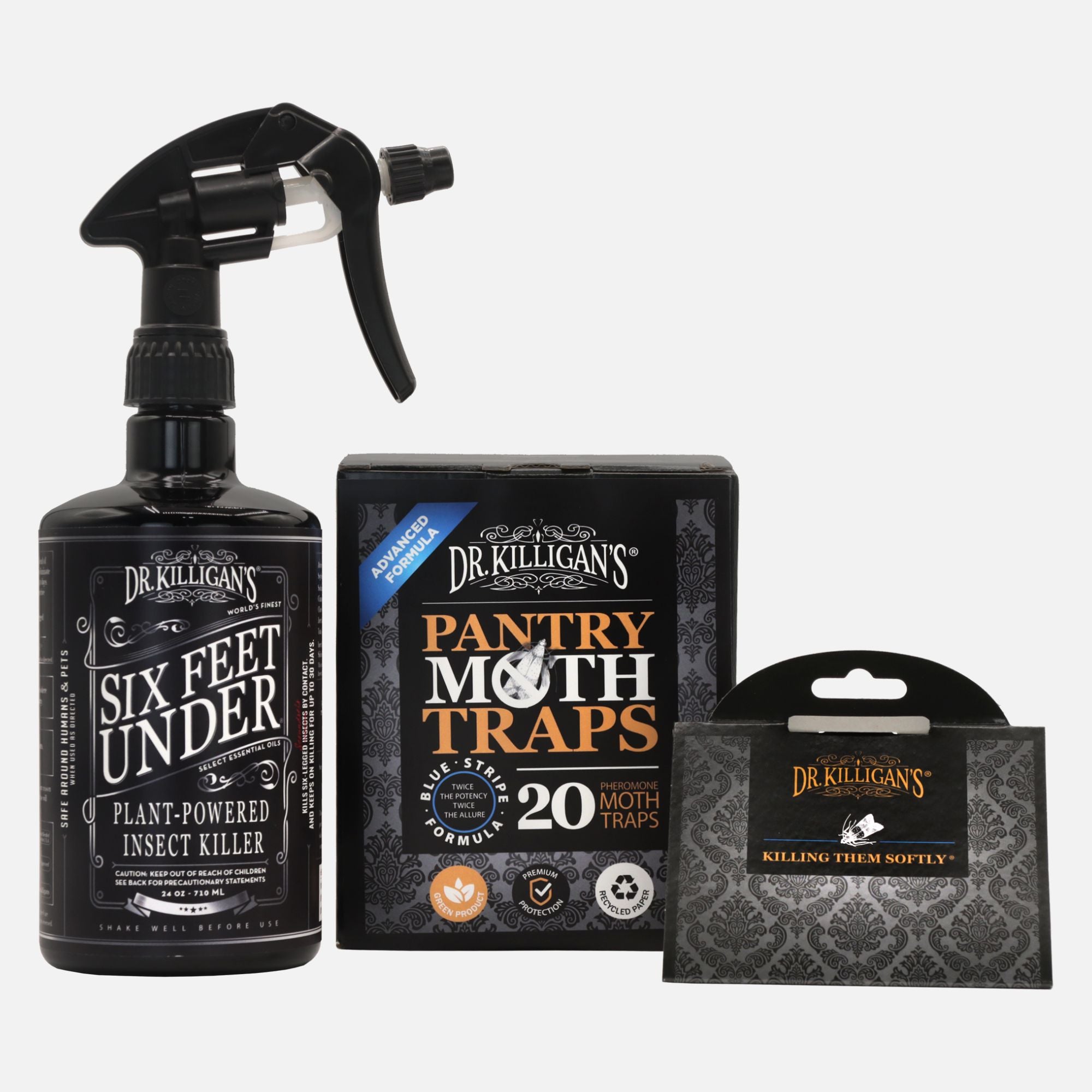Within a home, there could be as many as 100 species of insects, according to a study published in the journal Scientific Reports.
No home is impervious to insects. No matter where you live, you will have to face the potential of bugs. Once you come to this acceptance, you can begin to prepare your home or take measures to dispose of these pests for good.
Note: Wintertime provides a great opportunity to proactively prepare for an increase in insects during warmer months.
In this article, we'll guide you through identifying the six most common locations harboring insects, followed by the specific pests found in each and strategies for preventing their return.
1. Bugs in your kitchen
The first area we'll examine is the kitchen—a prime target for insects due to its abundant food and water sources, which attract a wide range of pests, including pantry moths, cockroaches, ants and flies.
Note: For more about common kitchen bugs, read Six most common bugs in your kitchen.

Pantry moths
Pantry moths—also known as Indian meal moths—target grains such as flour, rice and cereals, as well as accessible pet foods.
For insights on identifying and managing infestations, read Beyond breadcrumbs: 7 unexpected places you might find pantry moths and how to keep them out.
Cockroaches
Cockroaches are in search of water. They often inhabit areas under sinks where they can find moisture from leaks or damp cleaning rags. In addition to water, cockroaches are scavengers that feast on any available food sources, including scraps in trash cans and residue on dirty dishes.
For a deeper understanding of what attracts cockroaches, see What do cockroaches eat?
Ants
Ants are attracted to both moisture and sweet substances. They will exploit sugary spills, exposed fruit or sticky residues on containers. Their attraction to kitchens is driven by the easy access to both food and water sources, such as around sinks or areas where moisture accumulates.
Discover strategies to tackle infestations by visiting Ants, ants everywhere: Here's what to know and where to turn.
Flies
Flies thrive in environments where they have easy access to waste products. They are particularly attracted to the kitchen wastebasket, which accumulates food scraps from numerous meals, providing them with an abundant source of nourishment. If not managed properly, this can lead to a rapid increase in fly populations. Flies not only pose a nuisance but also a health risk.
For insights, read Is a fly landing on my food really that bad?
2. Bugs in your bathroom
Bathrooms naturally attract certain pests due to their moist and steamy conditions. The high humidity combined with regular water usage from showers, baths and sinks creates a prime habitat for various insects, including cockroaches, silverfish and ants.

Cockroaches
Cockroaches, in their quest for moisture, frequent bathrooms just as they do kitchens. These pests are attracted to leaky faucets, wet bath mats and condensation. Managing a cockroach infestation requires understanding their habits and effectively targeting their hiding spots.
For strategies, explore How to get rid of cockroaches.
Silverfish
Silverfish thrive in the high humidity of bathrooms. These insects are attracted to the starches found in many toiletries and can often be found in cabinets or under sinks where these items are stored.
For an effective approach to managing these pests, read How to get rid of silverfish.
Ants
Ants are particularly attracted to bathrooms due to the consistent availability of water. They often track along pipes and under sinks to reach moisture sources, and the persistent dampness and less frequented corners make bathrooms an ideal spot for ants to establish colonies unnoticed.
For tips on dealing with an ant infestation, visit How to get rid of ants.
3. Bugs in your bedroom
Maintaining a clean and food-free bedroom is crucial for keeping pests at bay. This section delves into common bedroom invaders such as bed bugs, clothes moths, and fleas and ticks, explaining their habits and how to prevent them.
Bed bugs

Bed bugs often remain undetected until infestations become severe. They can infiltrate your home through various means, such as hitching a ride on luggage after a vacation, being brought in with second-hand furniture or through visitors staying overnight. These pests, primarily residing in mattresses, can spread to other areas and feed on humans during the night.
For detailed information, visit Can I sleep in a bed with bed bugs?
Clothes moths
Clothes moths are common yet discreet pests that often reside unnoticed in the back of your closet, targeting your stored clothing. Unlike the moths attracted to light, these insects prefer dark, undisturbed areas where their larvae can feed on natural fibers such as silk, wool, cotton and linen.
For insights, explore Where do clothing moths live?
Fleas and ticks
If you have pets, expect to find fleas and ticks not just on your pets but throughout your home. Both pests can be a nuisance and a health hazard, thriving in and adapting well to domestic environments. Fleas are known for their quick, temporary bites and remarkable jumping abilities, while ticks will latch onto their hosts for longer periods.
To better understand fleas and ticks, read How long can fleas live in carpet? Dr. Killigan's unveils the truth and Do all ticks carry Lyme disease?
4. Bugs in your basement & attic
Basements and attics serve as prime real estate for a variety of insects due to their often undisturbed and cluttered nature. These areas of your home typically house seasonal items, infrequently used belongings and old furniture, creating ideal conditions for pests. Understanding the unique appeal of these spaces can help you better manage and prevent infestations, especially from clothing moths, cockroaches and spiders.

Clothing moths
Clothing moths often migrate from closets to basements and attics, attracted by the undisturbed environment and abundance of stored textiles. These spaces provide ideal conditions for moths to reproduce and feed unnoticed.
For guidance on what clothing moths eat, see Do clothing moths actually eat clothes?
Roaches
As the seasons change and we store seasonal supplies, our basements and attics become magnets for cockroaches. These pests are particularly drawn to cluttered and seldom-disturbed areas where they can remain hidden for extended periods.
For insights into the habits of common cockroaches, explore Common cockroaches and where you'll find them.
Spiders
Basements and attics provide the perfect trifecta for spiders: dark, cool and damp conditions. Ensuring these spaces remain free of excess clutter and moisture can help reduce their appeal to spiders.
For information on safeguarding your home against spiders, read How to protect your home from spiders.
5. Bugs in your garage
While not technically part of the home, garages are crucial to include as they can significantly impact the home if infested, especially when attached. They often serve as major entry points for bugs, especially spiders and birdseed moths (aka pantry moths).
Spiders

Garages, unlike the darker recesses of basements and attics, often become unintended sanctuaries for spiders, offering unique hiding spots amidst clutter and storage. In corners that rarely see disturbance—behind old boxes or between seasonal gear—spiders spin their webs and thrive in these quiet, undisturbed areas.
If you're curious about which spiders might be sharing your space, explore Which spiders are living in my home?
Birdseed moths (aka pantry moths)
Pantry moths, often associated with birdseed due to their presence in garages where birdseed and pet foods are stored, can lead to significant infestations. These pests, attracted to grains and seeds, lay their eggs among these staples, causing damage to unprotected dry goods. Similar to other pantry pests that feed on stored food, pantry moths require diligent management to prevent them from spreading.
To learn more, read How to get rid of birdseed moths.
6. Bugs in outdoor areas
Outdoor areas—including patios, porches, pools, gardens and work sheds—draw a variety of pests due to the abundant sources of water and food available. These areas can quickly become breeding grounds for common pests like mosquitoes and wasps—among many others.
Mosquitoes
Mosquitoes, thriving in standing water, can turn any stagnant pool into a breeding site, creating a nuisance and health hazard.
For strategies on managing these invaders, see Dr. Killigan's guide to banishing mosquito invaders.
Wasps
Wasps, attracted to food and sweet substances, can become aggressive protectors of their territory, making outdoor activities risky.
Learn how to manage and deter wasp populations by reading How to get rid of wasps.
What can I do to get rid of bugs in my house?
When you find yourself with an infestation of unwanted guests, search for the bug experts. Dr. Killigan’s creates premium pest control remedies that effectively dispose of bugs. Our team of professionals is dedicated to perfecting the art of Killing Them Softly. This is more than a motto we live by. We are driven to continue to raise the bar in developing safe, toxic-free pest control products for your home.
Six Feet Under Plant-Powered Insect Spray
Our most popular on-contact insect killer spray that will dispose of a wide variety of insects. It is made with a mixture of three oils—soybean, clove and cinnamon—and is safe to use around pets, children and food.
These effective traps halt the breeding cycles of various food moths including Indian meal moths, almond moths and Mediterranean flour moths by preventing females from laying eggs. This disruption stops larvae from hatching and damaging your food. Our traps feature a powerful pheromone infused directly into the non-toxic glue, ensuring ease of use and a sleek, discreet design that blends seamlessly into your pantry decor.

Trusted by The Smithsonian Institution and 100,000+ households, these pheromone traps are the leading solution to get rid of clothes moths once and for all.
This elegantly designed trap attracts flying insects with its open-top access and securely traps them against its sticky inner walls, concealing the catch from sight and keeping your windows clean and clear of dead insects. Perfect for maintaining both aesthetics and effectiveness in your home.
Dr. Killigan’s Insect Buster Bulb Duster
The Insect Buster is a bulb designed to disperse Dust to Dust Plant-Powered Insect Powdert. Dust to Dust is a powder insecticide that is non-toxic and non-poisonous. It is known to be safe for humans and has kill times up to 50% faster than diatomaceous earth. Dr. Killigan’s Insect Buster bulb is sturdy, easy to aim and easy to store with Dust to Dust inside of it.




















